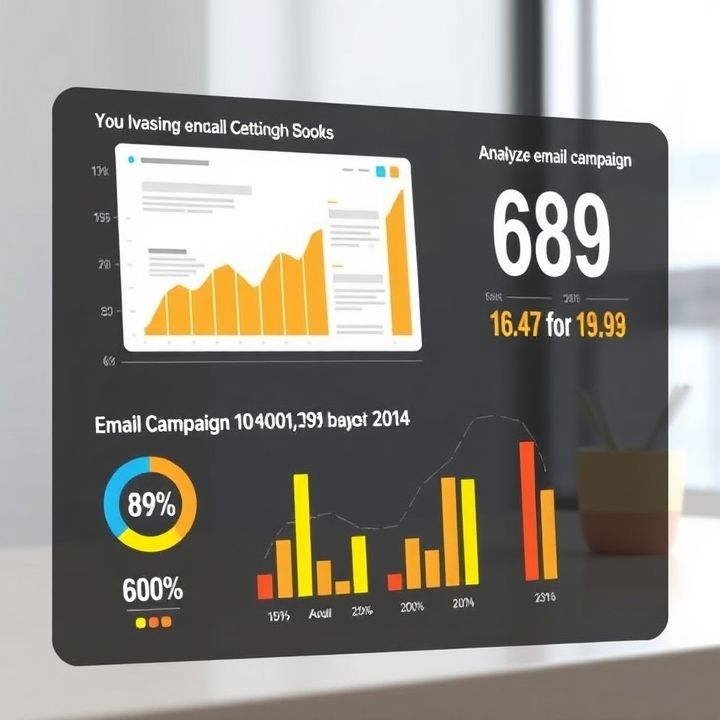Table of Contents
- Introduction
- Understanding the Importance of Customer Feedback in Email Marketing
- Collecting Effective Customer Feedback for Email Campaigns
- Analyzing Customer Feedback for Key Insights
- Utilizing Data Analytics to Understand Customer Preferences
- Segmenting Email Lists Based on Customer Data
- Personalizing Email Content Using Customer Insights
- Testing and Optimizing Emails Through A/B Testing
- Continuous Improvement by Monitoring Feedback and Performance Metrics
- Conclusion
- Frequently Asked Questions
Introduction
In the vast ocean of digital marketing, email campaigns remain one of the most powerful vessels to steer your brand towards success. But how can you ensure your campaigns achieve maximum impact and engagement in today’s ever-evolving landscape? The answer lies in the valuable insights that your own customers provide. Yes, customer feedback and data hold the key to transforming your email campaigns from ordinary to extraordinary!
Picture this: a seamless blend of creativity, data analysis, and personalized content that speaks directly to your audience, nurturing both their trust and curiosity. By unlocking the potential of customer feedback, you not only cater to their needs and preferences but also amplify the effectiveness of your marketing efforts.
Before you dive into the depths of how customer feedback can revolutionize your email strategy, let’s take a look at the core elements that form the foundation of a successful campaign:
| Element | Description |
|---|---|
| Personalization | Tailor content to resonate with individual customer preferences |
| Data Analysis | Leverage insights to fine-tune campaign strategies |
| Feedback Integration | Use direct customer input to enhance campaign effectiveness |
Understanding the Importance of Customer Feedback in Email Marketing
In the realm of email marketing, customer feedback serves as a critical compass, guiding your campaigns toward effectiveness and resonance. Gathering insights directly from your subscribers allows you to tailor your content to better meet their needs and preferences. This not only fosters a sense of trust and empathy but also enhances engagement and conversion rates.
Customer feedback provides you with a window into the minds of your audience, highlighting their likes, dislikes, and burgeoning needs. By analyzing this data, marketers can refine subject lines, optimize send times, and hone the overall content strategy to create a more personalized experience.
Utilizing feedback also enables you to make data-driven decisions. By implementing regular surveys, polls, or simply analyzing replies to your emails, you gather valuable information that can be pivotal in segmenting your audience and sending more targeted content. Ultimately, leveraging customer feedback improves the relevance and appeal of your email campaigns, fostering stronger relationships with your audience and elevating brand loyalty.
Collecting Effective Customer Feedback for Email Campaigns
Collecting effective customer feedback is essential for refining email campaigns and ensuring they resonate with your audience. Start by segmenting your audience into targeted groups, as personalized feedback is more actionable. This could be based on demographics, purchasing habits, or engagement levels. Encourage open communication by sending out surveys that are concise yet comprehensive, with a mix of multiple-choice and open-ended questions to capture a range of insights. Ensure that surveys are easy to complete, perhaps by optimizing them for mobile devices.
Implement feedback loops where you respond to customer input swiftly, showing that their opinions are valued and acted upon. Use incentives like discounts or freebies to increase response rates and engage your audience actively. Additionally, social media listening tools can offer real-time insights into what customers are saying about your brand and services. Incorporate these insights to tailor your email content, design, and frequency. Analyzing feedback data helps identify trends, preferences, and areas of improvement, allowing you to continually adapt and enhance your email marketing strategy for better engagement and conversion rates.
Analyzing Customer Feedback for Key Insights
Analyzing customer feedback is crucial for deriving actionable insights that can enhance your email campaigns. One effective method is to categorize feedback into positive and negative responses, helping you identify what resonates with your audience and what doesn’t. Look for recurring themes in the feedback, such as common issues with product offerings or suggestions for new features. This analysis can guide you in refining your email content or developing new campaigns that better align with customer interests.
Use tools like sentiment analysis software to quantify feelings expressed in feedback, which provides a measurable way to gauge customer satisfaction. Additionally, segment feedback by demographic data to understand diverse customer perspectives. This segmentation helps tailor your messages to different audience groups, improving the overall effectiveness of your emails.
Incorporating these insights into your campaigns can boost engagement rates and strengthen customer relationships. Regularly updating your email strategies based on current feedback ensures that your communications remain relevant and customer-focused. This ongoing process not only enhances the customer experience but also drives business growth by aligning your offerings with market needs.
Utilizing Data Analytics to Understand Customer Preferences
Utilizing data analytics to understand customer preferences is a vital aspect of modern email marketing campaigns. By leveraging customer data, businesses can gain deep insights into consumer behavior and tailor their messages accordingly. One effective method is to analyze open rates, click-through rates, and conversion metrics to gauge the effectiveness of current strategies. This information can provide a clearer picture of what content resonates with your audience.
For a more granular understanding, segmenting the audience based on demographics, purchase history, and browsing behavior offers opportunities to personalize email content. This personalization can significantly increase engagement levels as recipients are more likely to interact with content that feels relevant. Additionally, feedback from customers provides qualitative data that can be combined with quantitative analytics to refine messaging and improve customer satisfaction.
Another valuable approach is A/B testing, which allows businesses to test different email formats, subject lines, and content types. By analyzing the results, marketers can determine the most effective strategies. These insights can drive iterative improvements, ensuring that campaigns are continuously optimized to meet customer expectations. Therefore, mastering data analytics in understanding customer preferences is not just beneficial but essential for the success of email marketing efforts.
Segmenting Email Lists Based on Customer Data
Segmenting email lists based on customer data is a powerful strategy to personalize and improve email campaigns. It involves categorizing your subscriber list into smaller, more targeted groups based on specific criteria such as demographics, purchase history, or engagement level. This is crucial because it allows you to tailor the content of your emails to the preferences and needs of each segment, increasing the likelihood of engagement and conversion. For instance, you could create a segment for new customers and send them a welcome series to introduce your brand, or identify your most loyal customers and reward them with exclusive offers.
To effectively segment your email list, start by collecting and analyzing customer data. This could be obtained from previous interactions, purchase history, or feedback forms. Understanding your customers’ behaviors and preferences is key to creating relevant segments. Once you’ve identified the segments, you can customize your email content to suit each group, making your campaigns more relevant and engaging. Not only does this improve customer experience, but it also fosters brand loyalty and drives higher conversion rates. Overall, segmentation is a critical part of any effective email marketing strategy, enabling you to leverage customer data to its fullest potential.
Personalizing Email Content Using Customer Insights
Personalizing email content using customer insights is a powerful strategy that can significantly enhance the effectiveness of your email campaigns. By utilizing data collected from customer feedback and interactions, you can tailor your email content to meet the specific needs and preferences of your audience. This approach not only increases engagement and opens rates but also helps to build stronger relationships with your customers.
One effective method of personalizing email content is through segmentation. By dividing your email list into smaller, targeted groups based on demographics, purchase history, or behavior, you can send more relevant content that resonates with each recipient. Additionally, incorporating dynamic content such as personalized product recommendations, special offers, or exclusive invitations can further enhance the personalization of your emails.
Another essential aspect of utilizing customer insights for email personalization is analyzing customer feedback. Surveys, reviews, and direct feedback can provide valuable information about what your audience values, enabling you to tailor your messaging and offers accordingly. By continuously refining your approach based on these insights, you can ensure that your email campaigns remain relevant and effective, ultimately driving better results and higher customer satisfaction.
Testing and Optimizing Emails Through A/B Testing
A/B testing is a powerful method for optimizing email campaigns by evaluating different variables to see which version of an email performs better. The process involves creating two or more variants of an email campaign and segmenting your audience to receive these variations. This can be as simple as testing different subject lines, call-to-action buttons, or even the body content of the email.
Once your variations are sent out, you analyze the performance data to see which version generates more opens, clicks, or conversions. Key metrics to focus on include open rate, click-through rate, and conversion rate. By reviewing this data, marketers can make informed decisions about what resonates best with their audience.
Implementing A/B testing regularly helps in fine-tuning your messaging to better align with customer preferences, ultimately improving engagement and achieving better results over time. The key to successful A/B testing is consistency and a focused approach, ensuring each test is designed with a singular objective in mind. By leveraging the insights gained from these tests, you can continuously refine your email marketing strategy for optimal results.
Continuous Improvement by Monitoring Feedback and Performance Metrics
Continuous improvement in email campaigns is greatly enhanced by diligently monitoring feedback and performance metrics. Gathering customer feedback through surveys, polls, and direct responses can provide invaluable insights into what resonates with your audience. This feedback should be reviewed regularly to identify any recurring themes or suggestions that could enhance your campaign strategy.
Alongside qualitative feedback, performance metrics such as open rates, click-through rates, and conversion rates offer quantitative data that must be closely analyzed. These metrics help in understanding the effectiveness of various campaign elements, such as subject lines, call-to-action buttons, and email content.
Leveraging data analytics tools can significantly optimize this process by providing real-time updates and trends that could be crucial for timely adjustments. It’s essential to adopt a flexible approach, allowing your strategies to evolve based on the feedback and data received. Testing different hypotheses through A/B testing can also play a crucial role in refining your email campaigns.
By integrating feedback with robust data analysis, businesses can iteratively improve their communication strategies, ensuring that email campaigns are not only effective but also aligned with customer preferences, thereby maximizing engagement and conversion.
Conclusion
In conclusion, integrating customer feedback and data analytics into your email campaigns is no longer optional but essential for achieving exceptional results. By understanding the nuanced preferences and needs of your audience through detailed feedback and robust data analysis, you can craft highly personalized and effective email strategies that engage customers at every touchpoint. Implementing systematic methods for collecting and analyzing feedback allows you to continuously refine your approach, ensuring that your content resonates and remains relevant. Furthermore, leveraging A/B testing and segmentation offers an edge in optimizing and personalizing your communications, driving engagement and conversions. As businesses strive to deepen their customer relationships and brand loyalty, these insights prove invaluable. By remaining committed to a strategy of continuous improvement, you can ensure your email campaigns are finely tuned to meet the ever-evolving demands and expectations of your audience.

